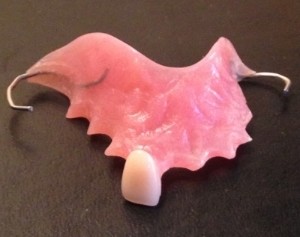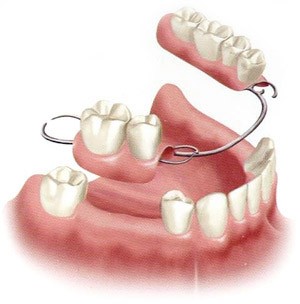Replacing a tooth that has been lost to trauma or disease is not a quick process. Often the extraction site will need time to heal, and if the tooth is to be replaced with a dental implant, additional procedures such as bone or soft tissue grafts may be required. This can mean going without a permanent replacement tooth for a few weeks or for several months.
Obviously this isn’t ideal, particularly as the loss of any tooth can affect the position and stability of those remaining and if the missing tooth is highly visible then its loss can be distressing. Flipper teeth are one solution to this problem.
In This Guide
- What is a flipper tooth?
- How much do flipper teeth cost?
- Who are they for? Adults or kids?
- Benefits
- Drawbacks
- What to Read Next
What is a Flipper Tooth?
 A flipper tooth is a removable, lightweight partial denture that is used as a temporary replacement for one or more missing teeth. It fills in any visible gaps so you don’t have to go without a tooth while waiting for a more permanent replacement.
A flipper tooth is a removable, lightweight partial denture that is used as a temporary replacement for one or more missing teeth. It fills in any visible gaps so you don’t have to go without a tooth while waiting for a more permanent replacement.
A flipper tooth can be constructed before the natural tooth is removed. It is made from pink gum-colored denture acrylic that supports the replacement tooth. It may have clasps that fit around existing teeth to help hold it in place. This appliance is easy for the patient to insert and is easily taken out for regular cleaning. A flipper also improves the ability to eat and chew food.
How Much Do Flipper Teeth Cost?
Flipper teeth typically cost between $300 and $500. The price depends on the number of teeth that require replacing and the type of materials used and can vary considerably. A flipper that has wire clasps for example, will cost more than one without.
Who are they for? Adults or Kids?
They can be used by adults who are missing a single tooth, or who have lost several teeth that are not adjacent to each other. Using flipper teeth can restore the appearance of natural teeth in a way that is immediate and inexpensive. While normally used as a temporary measure, some adults will choose flippers as a more permanent solution for tooth loss.
Dentists sometimes recommend flipper teeth for children who may have suffered damage to their front teeth and who are still waiting for their permanent teeth to come through. Wearing them can help restore a child’s self-confidence during this period, which can be an important consideration. They can enable a child with a missing tooth to maintain an appealing and pleasant smile.

Benefits
Affordable
They are inexpensive to make when compared to other options. This can provide valuable time to save up for more permanent and more expensive restorations such as a dental bridge or a dental implant.
Quick Solution
They can be used right after natural teeth are removed and are often pre-made prior to tooth removal.
Fewer Visits to the Dentist
They can often be made very quickly, requiring fewer visits to the dentist compared to a more permanent partial denture that may have a metal alloy substructure.
Lightweight
They are lightweight and some people find them easy to get used to wearing.
Improve Your Smile
They can instantly improve aesthetics, alleviating the embarrassment many people experience when they lose a tooth in a highly visible area in their mouth.
Can Be Modified
The structure of flipper teeth allows some degree of flexibility so if another tooth is lost within the year, the dentist can add this additional tooth to the denture.
Drawbacks
Weak
They are not very strong or stable, which can make it tricky to chew and some people choose to leave their flipper teeth out while eating at home.
Noticeable
The metal clasps sometimes used to hold them in place can be difficult to hide, making it more obvious that a person is missing one or more teeth.
Fragile
They are fragile and easily broken. A broken denture can only be mended by a dentist or by a dental laboratory and this may mean going without the flipper for a day or more while it is mended. Frequent breakages could prove increasingly difficult to mend.
Uncomfortable
The overall weakness of the material used to make them does mean that the base of the denture must be quite thick and broad. This additional thickness can make the denture uncomfortable, especially towards the end of the day after a long period of use.
Unhygienic
The design of a flipper can create unhygienic conditions in the mouth, preventing saliva from having a cleansing effect, particularly on the denture surface closest to the gums. If not meticulously cleaned, flippers can increase the risk of gum disease and tooth decay.
Can Become Loose
After only a short period of use, they can become increasingly ill-fitting and loose. This may mean they are uncomfortable to wear and will rub on the gums, increasing the risk of bone loss in these areas.
What to Read Next
Over to You
If you have flipper teeth or are considering getting them, I’d love to hear from you! How much did they cost? Were there any complications? Was it painful? Let me know in the comments.
I enjoyed hearing that information from you Rebecca Gordon! I am going through implant process AGONY as I type this, and have been thinking to myself while sitting here with stitches in my mouth and my mouth throbbing that there has to be something else other than this shit, and an easier way, less painful. I like those flippers and I think I really want one! Im in the process of a bone graph, but I have decided even after the graft heals, I am not following through with the implant. Im DONE with the drills and the PAIN. Id rather have a flipper..
I had flipper for 2 years I lost one tooth front side so we decided to take matching tooth . I not able to let go front teeth at time . Now going for my 2nd flipper it will be for my front 4 till I can get implants . I highly recommend one loved mine no issues light weight . Easy to use I would say it’s like retainer . And dentist says it last long . I had crown that loose it got decay so even though it be glued it can’t be filled so this what recommend. I hope love my new one like did the last one . Mine looks better than my original teeth but nateral.
I had my flipper done a few weeks ago..it is hars to get used to. I had an adjustment done already because the roof was very thick..I am hoping i can get used to havong thia big blob in the roof od my mouth.
Any tips on how to get used to it.
I’ve had my flipper for 12 years(same one) and have had NO issues. I am missing two teeth in front since my teen years. I had a bridge and my teeth moved. I hated my teeth for years because they looked so obviously different. Finally, I went to a dentist and he suggested we remove the horrible bridge and try a flipper. I still remember crying when he put it in because my teeth looked so amazing. It cost me $200. I do everything with it and love it. There is absolutely no way I would pay the ridiculous amount of money they want for a bridge or implant. If you do have issues with your flipper, go back and they can adjust it. Dentists make virtually no money from a flipper, so of course they want you to go a more expensive route. Go with the flipper.
Unfortunately had to wait a few days after having bottom teeth pulled, to receive my flipper. Took several adjustments to make it not hurt. My only complaint, I have to use adhesive now…